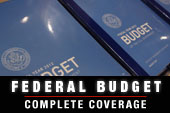On March 12, Rep. Paul Ryan of Wisconsin, chairman of the House Budget Committee and former vice presidential nominee of the Republican Party, unveiled the latest version of a budget proposal he has been promoting for several years. Republicans in both the House and Senate have rallied around it as their blueprint to slash government by cutting both taxes and spending.

Those unfamiliar with the peculiarities of the budget process may be inclined to attach more importance to the Ryan budget than it deserves. The truth is that the U.S. doesn’t really have a budget in any meaningful sense of the term--at least not one that is remotely comparable to, say, the British budget. There, the prime minister presents the budget, which is enacted by Parliament the same day.
Until the 1920s, the U.S. budget was simply whatever Congress spent, totaled up at the end of the year. Only in 1921 was there a law requiring the president to present a budget to Congress in advance of the fiscal year, which began on July 1 in those days.
For many decades, the president’s budget was essentially the national budget. Congress made adjustments in its annual appropriations bills, but only the president had sufficient information to really know what was going on in the vast number of federal spending programs. Hence, his proposals were generally followed.
Under this budget process, presidents would often exercise what was called impoundment authority. Basically, they could cut spending by just not spending funds appropriated by Congress. Congress always hated this and was able to enact legislation in 1974, while President Nixon was weakened by the Watergate scandal, that abolished impoundment. Presidents are now forced to spend every dollar appropriated by Congress for that purpose and that purpose only.
Another important fact about the federal budget is that most of it is essentially on automatic pilot. All entitlement programs, such as Social Security and Medicare, in effect have permanent appropriations. Money for such programs is spent automatically without the need for additional congressional action. The same is true for interest on the debt and other spending.
The Budget Act of 1974 also established a new congressional budget process. Following presentation of the president’s budget, the House and Senate are supposed to adopt a resolution establishing caps on broad categories of spending, which would then guide the appropriations process. The Congressional Budget Office was established to give Congress its own budget data and the start of the fiscal year was moved to Oct. 1.
It’s important to understand that the congressional budget resolution doesn’t carry the force of law. Indeed, the president plays no role in the process. It is enforced by internal congressional rules. It is not a budget in any meaningful legal sense of the term; it is not a substitute for passing annual appropriations bills necessary to keep the government running.
For some years, Congress has not adopted a budget resolution and reverted to earlier ad hoc budget methods. This year, the president has yet to send a budget to Congress due to extra work required by last-minute tax changes that weren’t enacted until Jan. 1. Ordinarily, a budget would have been sent to Congress by Feb. 1.
For some time, conservatives have enjoyed complaining that the Senate has failed to pass a budget, as if this is a damning indictment. It strikes average people as irresponsible. But all that means is that the Senate has not passed a budget resolution, something that never existed before 1974--nothing more.
Compounding the confusion is the fact that Congress has yet to finish appropriating funds to keep the government operating past March 27 (a continuing resolution). Normally, all such work would have been completed before Oct. 1 of last year. Republicans, who control the House, have refused to complete the appropriations in order to have some political advantage over President Obama.
Moreover, an across-the-board reduction in current spending took effect on March 1. Known as a sequester, it was enacted in 2011 in order to force Congress to enact a long-term deficit reduction plan. That effort having completely failed, everyone now seems resolved to living with this meat-ax approach to spending cuts.
At this point, the president’s budget is not expected until April 8 and both Congress and the White House are still negotiating a permanent budget for the rest of fiscal year 2013. There is no guarantee that such negotiations will be successful and the possibility that the federal government will shut down on March 28 cannot be dismissed.
Still looming, as well, is another debt limit crisis when the most recent increase expires on May 19. In 2011, Republicans bragged about holding the debt limit hostage to their demands. Some are saying they plan to do so again this year.
Rep. Ryan’s proposal is less an effort to rationalize the U.S. budget situation than the opening bid in the continuing budget war, which promises to be just as contentious as last year’s. It’s about making extravagant promises to Republican voters about how the budget can be balanced, taxes can be cut simultaneously, and no one’s pet program will suffer.
In short, the Ryan plan is mainly a political document for the party faithful rather than a workable budget outline. The real dirty work on getting the US budget on a sustainable long-term path that at least stabilizes the debt-to-GDP ratio won’t begin until the budget for fiscal year 2013 is finished and the White House finally sends its budget to Capitol Hill.






